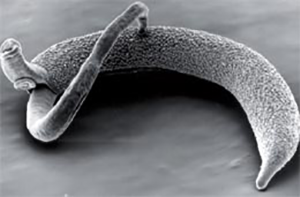|
|
Schistosomiasis research within the CDIPD is focused on the development of new generation therapeutics for the treatment of this insidious neglected tropical disease. Our drug discovery and development program for schistosomiasis began during the early TDRU days (see History) with a focus on the digestive proteolytic enzymes that allow the worm to feed on blood and grow. We maintain that research theme to this day working with collaborators in the Czech Academy of Sciences. We are also interested in other molecular targets including kinases, phosphodiesterases, enzymes in the mevalonate pathway, and most recently, the proteasome.
Tool- and technology-development to identify drugs and drug targets, and learn more about the biology of the schistosome, has been a major part of our schistosome research.
- With colleagues at the University of Giessen, Germany, the CDIPD pioneered the use of biolistic transfection of genetic material into the adult schistosome to visualize the transcription of proteolytic enzymes with green or red fluorescent proteins.
- We established a rigorous protocol for successful RNA interference in the schistosomula stage of the parasite with which the suppression of transcription of individual genes could be assessed.
- With colleagues at UC San Francisco we demonstrated that the nematode model C. elegans could be used as a surrogate to functionally express and characterize genes from the phylogenetically distant schistosome flatworm.
- The CDIPD developed "WormAssay" - a camera based software to measure worm parasite motility in response to drugs
- With colleagues at UC San Francisco and San Francisco State University, we designed and developed a number of novel phenotypic screening platforms using state-of-the-art high-content imaging and computational tools to capture and measure the multi-parametric responses of the schistosome parasite to anti-schistosomal compounds.
- With Collaborations Pharmaceuticals Inc. we employed AI to increase our "hit rate" in the identification of new anti-schistosomal compounds.
- We also have an animal model of schistosome infection with which we characterize the efficacy of candidate small molecules of particular interest.
Overall, we adopt innovative, flexible, and pragmatic approaches to our research, and engage with both the pharmaceutical industry and academic collaborators to identify new and promising anti-schistosomal compounds, as well as advance the technologies associated with that endeavor.

